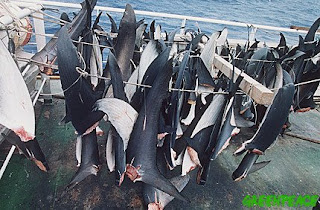








Up to date information about several species of sharks, videos, news, and more!















 What do they look like?
What do they look like?Tiger sharks are about 10 to 14 feet long typically, although they can get as big as 20 feet. They have dark stripes on their back and along their side that resemble markings on a tiger. The stripes fade (with age) to gray or brownish in color. These sharks have a broad, blunt nose, a large wide mouth, and a husky body. They have a whitish underbelly and a long tapered back fin.  Teeth
Teeth
The tiger shark has very distinct dentintion. The jaws house large teeth with curved cusps and finely serrated edges. Each tooth has a deep notch on the outer margin lined with numerous cusplets. Upper and lower teeth are similar in shape and size and decrease in measurement as they move back toward the mouth's corners.
What do they eat?
Where are they?
The tiger shark is found throughout the world's temperate and tropical waters, with the exception of the Mediterranean Sea. It is a wide-ranging species that is at home both in the open oceans as well as shallow coastal waters.
The goblin shark is a medium-to-large shark. Typically, specimens are 6.6 feet to 9.8 feet in length. Their fins are not pointed and instead are low and rounded, with the anal and pelvic fins significantly larger than the dorsal fins. Their heterocercal tails are similar to the thresher shark's, with the upper lobe significantly longer proportionately than other sharks'. In addition, the goblin shark's tail lacks a ventral lobe.

They can be found throughout the world, from Australia in the Pacific Ocean to the Gulf of Mexico in the Atlantic Ocean. They are best known from the waters around Japan, where the species was first discovered by modern science in 1897. In 2003, more than a hundred goblin sharks were caught off the northwest coast of Taiwan, an area in which they had previously not been found. Reportedly, the sharks were caught a short time after an earthquake occurred in the area.
Very little is known about the species' life history and reproductive habits, as encounters with them have been relatively rare. As seemingly rare as they are however, there seems to be no real threat to their populations and so they are not classified as endangered species by the IUCN.
 The whale shark is a slow filter feeding shark that is the largest living fish species. This shark is found in tropical and warm oceans and lives in the open sea. They are slow swimmers.This species is believed to have originated about 60 million years ago.
The whale shark is a slow filter feeding shark that is the largest living fish species. This shark is found in tropical and warm oceans and lives in the open sea. They are slow swimmers.This species is believed to have originated about 60 million years ago. 




